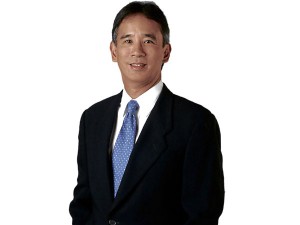MANILA, Philippines—It’s not often that shareholders give a standing ovation at the end of the president’s annual report but Aurelio “Gigi” Montinola III got what he deserved as he bowed out as chief of Bank of the Philippine Islands on April 18.
Montinola, who had worked at BPI for 31 years of which the last eight years was as president and chief executive officer, brought the bank to its “special” place at present, BPI chairman Jaime Augusto Zobel de Ayala says and for this, he expresses profuse gratitude.
Zobel de Ayala says Montinola had built BPI into a “more customer-centric” financial institution that’s at par with global standards.
Minority shareholders and BPI staff share the same sentiment and they pay a moving tribute to Montinola at the end of his term.
In a video tribute, much was said about his being a “people person.” Key government officials likewise had something good to say. Interior and Local Government Secretary Mar Roxas describes Montinola as the “cool voice of reason whenever things got really turbulent.” Finance Secretary Cesar Purisima describes the banker as “low intensity but effective, helpful and non-threatening.”
The Ayala-led bank, the oldest bank in Southeast Asia, is the only investment grade bank in the Philippines (getting such an upgrade right after Fitch Ratings upgraded the sovereign credit rating) and is likewise the most valuable and profitable among its local peers at present.
In its report, Fitch Ratings says: “BPI’s ratings have been the highest, due to its established domestic presence, sound financial metrics and prudent management.”
His predecessor Xavier Loinaz took the big steps and embarked on a number of mergers and acquisitions (M&As) to take BPI to a certain scale and size. Montinola in turn led BPI to the peripheries, broadening its market with the going down-market strategy. As a bank operating in an emerging market, part of BPI’s role is to ensure greater financial inclusion, seen as a key component to building a “stronger and a more empowered nation,” Zobel de Ayala says.
Under Montinola’s leadership, BPI acquired Prudential Bank (2005) and the local trust business of ING (2011). A bancassurance partnership was established with the Philamlife group and a mobile banking unit BPI Globe BanKO was set up, tapping synergies within the Ayala group. A European unit BPI Europe was likewise established to reach out to more overseas Filipinos.
At the end of his term, Montinola left BPI with a customer base of six million, adding about one million in 2012 alone.
“We believe in saying that if you focus on your customers and employees, the business results will follow,” Montinola says. Over the last four years, BPI focused on democratizing senior management education. Among its various programs, the BPI Leadership Excellence Acceleration Program (BPI LEAP), a partnership with Harvard Business Publishing, stood out for its breadth and scope. For this, People Management Association of the Philippines awarded this program as “People Program of the Year” for 2012.
Montinola, who was also previously a president of the influential Bankers Association of the Philippines, was himself named “Management Man of the Year” for 2012.
Turnover
Montinola turns over leadership of BPI to Cezar Consing, who has over 25 years of experience in international finance, particularly in investment banking, commercial banking, and private equity. After his retirement (his term was extended for two years after he hit the retirement age of 60), Montinola says he’ll be able to help out his mother—Lourdes Montinola, who chairs Far Eastern University—in family interests.
Montinola’s successor, Consing, started his involvement in BPI in 1981 when he became the youngest management trainee in BPI. He then joined J.P. Morgan & Co. as a transferee from BPI and built a 20-year career in investment banking while based in Hong Kong and Singapore, the last seven years of which as head or co-head of investment banking for Asia Pacific between 1997 and 2004. From 2001, Consing was president of J.P. Morgan Securities (Asia Pacific) Ltd. and had overall responsibility for the combined Asian investment banking businesses of J.P. Morgan, Chase Manhattan and Jardine Fleming.
At the BPI board level, Consing had represented J.P. Morgan on the boards of directors of BPI and BPI Capital in 1995 to 2000. He rejoined the BPI board as an independent director from 2004 to 2007, and then again, in 2010, where he served as an independent director.
Montinola says under Consing’s new leadership, BPI was in a good position to be “one of the best Asean banks in the near future.” He also says BPI was well-prepared for the full implementation of Basel 3 capital adequacy framework by January 2014.
With a tier 1 or core capital of 14.2 percent, Montinola says BPI was ready for Basel 3, a new global framework for capital adequacy which introduces a complex package of reforms designed to improve the ability of banks to absorb losses, extend the coverage of financial risks and have stronger firewalls against periods of stress.
Antonio Paner, BPI executive vice president, says the present capital of BPI could sustain growth through 2017 on assumption of a sustainable annual loan growth of around 15 percent. “Of course acquisition is not into that projection. If something happens, we will look at it,” he says. BPI had discussions for a prospective consolidation with Philippine National Bank but this didn’t happen within Montinola’s term.
BPI is ready to be benchmarked to be among the best in Southeast Asia, Montinola says during his last briefing as BPI president. “Increasingly, the world and analysts are looking at the Asean (Association of Southeast Asian) region as opposed to just country by country, beginning to compare banks across the region. That’s why we ourselves are preparing ourselves to be compared, in the region and try to mimic what the good banks are doing.”


